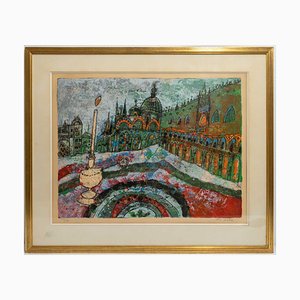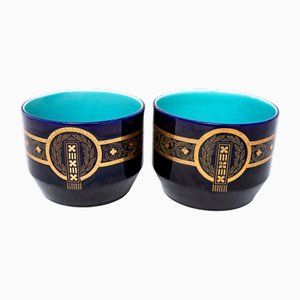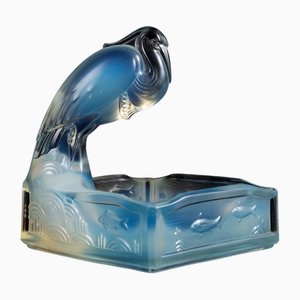Magnificent piece of furniture known as collectors in solid oak. It has a display case in the upper part and opens on the front with 4 drawers.
This centerpiece piece of furniture is based on a plinth and has a secret closing mechanism.
Period: Louis-Philippe - Beginning of the 19th
Circa: 1835 - 1840
Dimensions: Height: 78cm x Width: 65cm x Depth: 46cm
In the 19th century, the collection became a social fact, certainly because it in turn embodied the educational role of the Republican discourse, then the desire to fill the private sphere with art, in the face of the fear of the new world which was born at the end of the century.
In the 1840s: the collector is seen as an asocial eccentric. He is passionate but more associated with the madman than with the scholar.
Often solitary, the latter's collection is a refuge for him. However, the practice of collecting spreads and gradually contaminates the bourgeois ...
In the 1860s, the opening of the Drouot auction house brought together the most learned Parisians. The development of private collections is done at the same time as the opening of some museums (the Cluny 1844 museum - the Saint-Germain-en-Laye 1854 national antiquities museum).
Collectors have therefore acquired real legitimacy and are no longer on the margins but at the head of civil society. The practice gradually affected all the amateurs whose number increased from year to year and then became a fact of fashion, but this only attested from the 1870s.
In the 1870s everyone collected. The practice of collecting has become a norm. These are then very diversified since everyone collects, it is necessary to stand out by the works and objects collected. The collection thus encourages the sociological analysis of its constitution, what is collected reflects the tastes and social environment of the collector.
Magnificent Möbelstück als Sammler in massiver Eiche bekannt. Es hat eine Vitrine im oberen Teil und öffnet sich auf der Vorderseite mit 4 Schubladen.
Dieses Herzstück der Möbel ist auf einem Sockel basiert und hat einen geheimen Schließmechanismus.
Periode: Louis-Philippe - Anfang des 19
Zeitrechnung: 1835 - 1840
Abmessungen: Höhe: 78cm x Breite: 65cm x Tiefe: 46cm
Im 19. Jahrhundert wurde die Sammlung zu einer sozialen Tatsache, sicherlich weil sie die erzieherische Rolle des republikanischen Diskurses verkörperte, dann den Wunsch, den privaten Bereich mit Kunst zu füllen, angesichts der Angst vor der neuen Welt, die am Ende des Jahrhunderts entstand.
In den 1840er Jahren: Der Sammler wird als asozialer Exzentriker gesehen. Er ist leidenschaftlich, wird aber eher mit dem Verrückten als mit dem Gelehrten in Verbindung gebracht.
Oft ist er einsam und seine Sammlung ist für ihn ein Zufluchtsort. Die Sammeltätigkeit breitet sich jedoch aus und kontaminiert allmählich das Bürgertum ...
In den 1860er Jahren bringt die Eröffnung des Auktionshauses Drouot die gelehrtesten Pariser zusammen. Die Entwicklung der Privatsammlungen geht mit der Eröffnung einiger Museen einher (Museum von Cluny 1844 - Nationales Museum für Altertümer von Saint-Germain-en-Laye 1854).
Die Sammler haben also eine echte Legitimität erlangt und stehen nicht mehr am Rande, sondern an der Spitze der Zivilgesellschaft. Diese Praxis erfasste allmählich alle Amateure, deren Zahl von Jahr zu Jahr zunahm und schließlich zu einer Modeerscheinung wurde, was jedoch erst ab den 1870er Jahren belegt ist.
In den 1870er Jahren sammelte jeder. Die Praxis des Sammelns ist zur Norm geworden. Diese sind dann sehr vielfältig, da jeder sammelt, ist es notwendig, sich durch die gesammelten Werke und Gegenstände hervorzuheben. Das Sammeln fördert somit die soziologische Analyse seiner Beschaffenheit, was gesammelt wird, spiegelt den Geschmack und das soziale Umfeld des Sammlers wider.




















Schreiben Sie uns
Ein Angebot machen
Uns ist aufgefallen, dass Sie neu bei Pamono sind!
Bitte akzeptieren Sie die Allgemeinen Geschäftsbedingungen und die Datenschutzerklärung
Schreiben Sie uns
Ein Angebot machen
Fast geschafft!
Um die Kommunikation einsehen und verfolgen zu können, schließen Sie bitte Ihre Registrierung ab. Um mit Ihrem Angebot auf der Plattform fortzufahren, schließen Sie bitte die Registrierung ab.Erfolgreich
Vielen Dank für Ihre Anfrage! Unser Team meldet sich in Kürze bei Ihnen zurück.
Wenn Sie Architekt*in oder Inneneinrichter*in sind, bewerben Sie sich hier um dem Trage Program beizutreten.